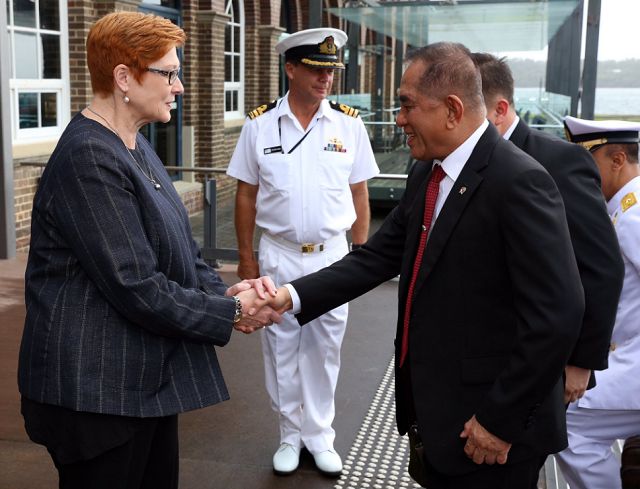
Last week Indonesian defence minister, Ryamizard Ryacudu, met with his Australian counterpart, Marise Payne, for the annual Indonesia–Australia Defence Ministers’ meeting. On the face of it, defence relations between Indonesia and Australia seem to be back on track following the brief suspension of defence language training cooperation in December. Indeed, the broad priorities and common interests discussed in the meeting were encouraging.
Minister Payne highlighted the importance of ASEAN security frameworks as well as the support for the recently signed Joint Declaration on Maritime Cooperation. Issues relating to defence science and technology as well as regional peacekeeping were also raised.
From the Indonesian side, Minister Ryacudu addressed the issue of American military presence in Australia and his expectation that Australia might encourage South Pacific states to support Indonesia’s territorial integrity. He also emphasised President Widodo’s Global Maritime Fulcrum (GMF) vision and Indonesia’s role in the Indian Ocean Rim Association.
We should now consider broad recalibrations at three levels to strengthen the defence relationship and make it less ‘incident-prone’. First, at the bilateral level, President Widodo’s GMF doctrine could become a starting point to strategically align our mutual interests. Although the doctrine was launched in 2014, the policy priorities and programs only materialised after he signed Presidential Regulation No. 16 on Indonesian Sea Policy late last month.
The decree came with both with a long-term framework and a short-term action scheme (see breakdown here). These documents reflect the government’s desire to achieve a dozen maritime-related goals ranging from marine sustainability to diplomatic initiatives. They could also serve as a ‘set of menus’ through which Canberra could tailor and refine the recent joint maritime declaration—whether they relate to the economy, security, or even people-to-people exchanges. Strategically linking bilateral relations to Jakarta’s GMF and Sea Policy provides some domestic political cushion in Jakarta, helps generate a substantive framework for discussion, and elevates the regional potential of the partnership.
Second, at the defence level, TNI–ADF dynamics shouldn’t be the sole determinant of the relationship. Instead, defence ties could be stabilised by expanding and institutionalising the role of non-military security actors—such as police forces and coast guards—as well as non-government actors. Defence relations, after all, are increasingly tasked with addressing the growing complex nexus of traditional and non-traditional security challenges. Indonesia’s civilian defence community could be a valuable partner to the TNI and, when sufficiently developed and institutionalised, a useful bridge to the Australian strategic community.
Finally, we need to reinforce but modify existing military education and training programs as the lynchpin of the TNI–ADF relationship and better align them to the strategic maritime interests of both countries. We might reassess, for example, Australia’s army-centric training programs for the TNI. None of the top ten education and training courses conducted between 1999 and 2015—which trained almost half of the Indonesians—were explicitly maritime-related. In fact, there were only 82 TNI soldiers and officers (around 5%) that went through seven explicitly maritime-related courses. Those courses ran for an average duration of six weeks compared with English language training programs which averaged twice as long.
Given Indonesia’s current maritime focus we should now consider options to boost the number and duration of maritime-related courses, which could range from maritime safety and security, naval shipbuilding, to marine environmental science and engineering as well as counter-trafficking operations at sea. We should also assess whether security-related courses could be expanded to include more participation from Indonesia’s civilian defence community in areas such as defence policymaking, maritime operations law, or defence management.
These maritime-driven recalibrations could gradually both broaden and deepen defence ties between Indonesia and Australia. But as these are long-term evolutions and Jakarta and Canberra need to exercise strategic patience for the time being. The maritime geography that binds us as neighbours doesn’t need to condemn us to perpetual crises.

